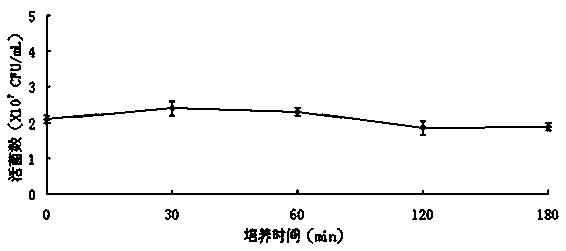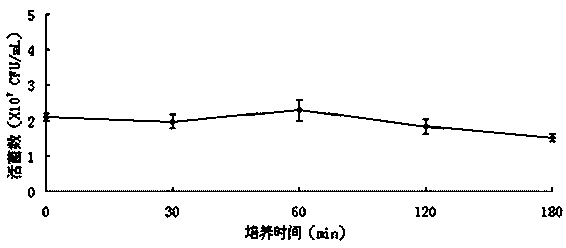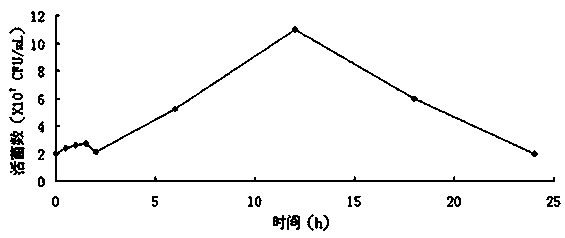High-activity lactobacillus plantarum for feeding, and culture method and application of high-activity lactobacillus plantarum
A technology for Lactobacillus plantarum and feeding, which is applied in the field of highly active Lactobacillus plantarum for feeding and its cultivation, can solve the problems of low fermentation level, high price, increased cost, etc., and achieves inhibition of proliferation, reduction of use, and improvement of livestock and poultry production. effect of ability
- Summary
- Abstract
- Description
- Claims
- Application Information
AI Technical Summary
Problems solved by technology
Method used
Image
Examples
Embodiment 1
[0032] Example 1: Isolation and identification of Lactobacillus plantarum WEI-70 CGMCC No.11747:
[0033] Weigh 25 g of feces from 60-day-old healthy piglets, put them into an Erlenmeyer flask filled with 225 mL of sterilized 0.85% normal saline (20 sterile glass beads are placed in the Erlenmeyer flask in advance), shake at 37 °C and 180 rpm For 30 min, draw 1 mL of the suspension for ten-fold incremental dilution, select 2-3 appropriate dilutions, draw 1 mL of the dilution into a sterile petri dish, and make two parallels for each dilution; Add MRS agar medium that was melted and cooled to 46°C into the petri dish of liquid solution, rotate the petri dish carefully to fully mix the sample with the medium, and incubate at 37°C for 48-72 h. Colonies of different shapes were selected from the petri dish, streaked and purified, stored separately and identified by 16S rDNA sequencing.
Embodiment 2
[0034] Example 2: Lactobacillus plantarum (Lactobacillus plantarum) WEI-70 CGMCC No.11747 tolerates low pH gastric juice, pig bile salt and artificial gastrointestinal digestive juice:
[0035]Pick a ring of lawn from the preserved slant (MRS medium) of Lactobacillus plantarum WEI-70 CGMCC No.11747 and inoculate it in a 250 mL Erlenmeyer flask containing 100 mL liquid MRS medium. After culturing for 18 h, the bacterial solution was centrifuged at 6000 rpm for 10 min, the supernatant was discarded, washed once with sterilized 0.85% normal saline, and then suspended with the same volume of normal saline. Draw 10 mL of the suspended bacterial liquid and connect them to 250 mL triangular flasks filled with 90 mL of artificial gastric juice with pHs of 1, 2, 3, 4 and 5 and 90 mL of artificial porcine bile salt solution respectively. g / L, 5 g / L, 10 g / L, 15 g / L, 20 g / L, three parallels were done for each condition, and the sample without bile salt was used as the control. Then at 37...
Embodiment 3
[0037] Example 3: Bacteriostatic activity of Lactobacillus plantarum (Lactobacillus plantarum) WEI-70 CGMCC No.11747:
[0038] 1. Preparation of the culture plate:
[0039] Pick a ring of bacterial lawn from the preserved slant (MRS medium) of Lactobacillus plantarum (Lactobacillus plantarum) WEI-70 CGMCC No.11747 and inoculate it in liquid MRS medium, culture at 37 °C for 18 hours, and take 0.1 mL of bacterial liquid to spread Incubate on MRS plate at 37°C for 48 h.
[0040] 2. Preparation of antibacterial activity detection plate:
[0041] After diluting the LB culture solution of the indicator bacteria 100 times, pipette 0.1 mL of the bacteria solution and spread it on the LB plate. Incubate overnight at 37°C. The indicator bacteria include Escherichia coli, Salmonella, Streptococcus and Staphylococcus aureus.
[0042] 3. Determination of antibacterial activity:
[0043] Use a sterile puncher to punch holes on the culture plate of Lactobacillus plantarum (Lactobacillus...
PUM
 Login to View More
Login to View More Abstract
Description
Claims
Application Information
 Login to View More
Login to View More - R&D
- Intellectual Property
- Life Sciences
- Materials
- Tech Scout
- Unparalleled Data Quality
- Higher Quality Content
- 60% Fewer Hallucinations
Browse by: Latest US Patents, China's latest patents, Technical Efficacy Thesaurus, Application Domain, Technology Topic, Popular Technical Reports.
© 2025 PatSnap. All rights reserved.Legal|Privacy policy|Modern Slavery Act Transparency Statement|Sitemap|About US| Contact US: help@patsnap.com



